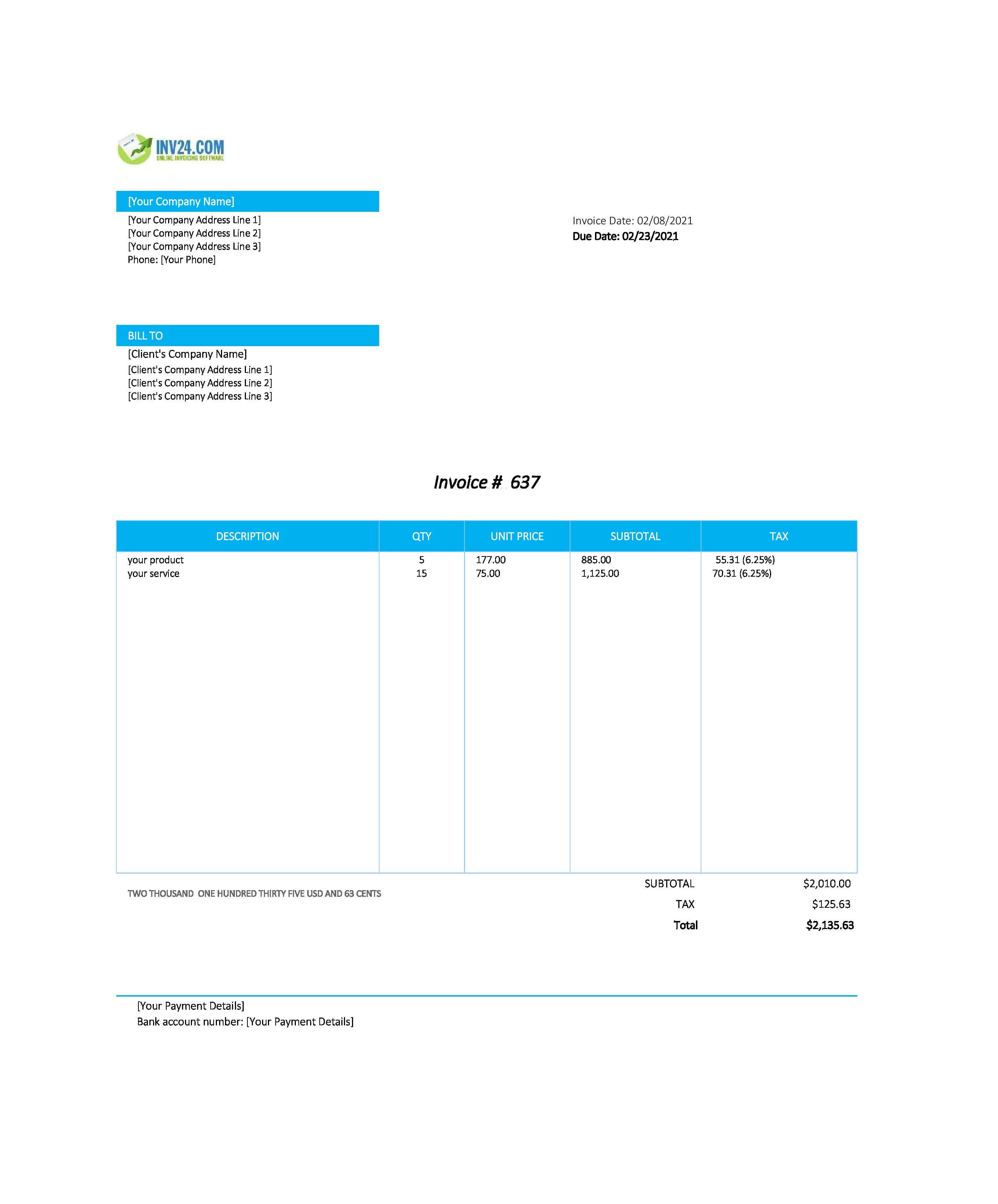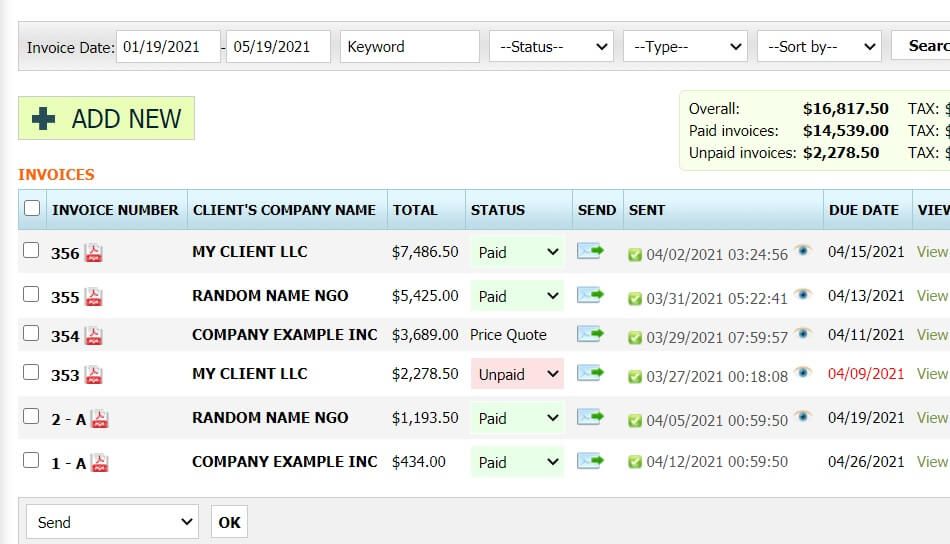Sales Invoice
A sales invoice is a legal document sent from a seller to the buyer. It contains pertinent details relating to the sales transaction such as the product or service descriptions. Other specific details related to the specific sales transaction includes applied rate, invoice date, due date, tax rate, tax amount and total amount.

In addition to the above, general details such as customer details, supplier details, delivery address and contact details are also included in the invoice.
Purpose of a Sales Invoice
The sales invoices is not only limited to requesting payment but also serves a number of essential functions which include the following:
Source document for bookkeeping
The sales invoice acts as a source document for updating accounting records. So the revenue in the financial statement is backed by multiple sales invoices issued during an accounting period. This is why auditors trace revenue with sales invoices and this process its called vouching.
Source document for TAX return
The sales invoice is a source to verify claims made on the TAX return. For instance, the output tax in the TAX return is an accumulation of sales tax charged from customers during a certain month. This makes the sales invoice an essential document in the case of tax audit as it is a major source that is used to verify output tax charged from customers.
Enhanced inventory management (for business selling goods)
Sales invoices can be used to track total units sold during the accounting period. This data helps to understand seasonal demand or variation, trending products and overall sales prediction and forecasting. This makes sales invoices a useful tool to predict and manage inventory as you can track demand for specific items by looking at selling trends.
Useful for forecasting / budgeting
A sales invoices is an essential tool that allows the prediction of future cash flow and also helps to create a more precise budget. In the case of product-based businesses, the majority of expenses are dependent on the volume of sales. So if sales are higher, then related expenses are higher and vice versa. So if the understanding of sales invoices is good, it can help to create an enhanced sales budget which will then result with better budget formation for the overall business.
Legal documentation
Should there be any dispute between the seller and buyer, the invoice acts as evidence to prove the legitimacy of the transaction. This is due to the fact that the sales invoice is a legal binding agreement between the seller and buyer.
How to Create a Sales Invoice
Method 1: Use our simple invoice software
Method 2: Download a free sales invoice template:
Sales Invoice (Accounting Perspective)
From an accounting perspective, a sales invoice is a document issued by a seller to record sales in the financial statement. It is a source document that is used to post transactions in the accounting ledger. It is important to note that to record sales, the business would need to transfer risks and rewards first.
On the other hand, if money is received from the customer before the goods are dispatched (before risk and rewards are transferred to the customer), the money received is recorded as a liability. Once the goods are dispatched, the liability is removed and sales is recorded.
How to Record a Sales Invoice (Sales Invoice Journal Entry)
A sales invoice is recorded by the following journal entry:
| Description | Debit | Credit |
| Accounts receivable | XXX | |
| Sales/revenue | XXX |
The debit impact of this transaction is the recording of accounts receivable. This is because the business has established its right to receive economic benefits from the customer. On the other side of the transaction, the credit impact is the recording of sales as the business has delivered products or performed services for the customer.
It is important to realize that once cash or the economic benefit is received from the customer, accounts receivable is removed from the accounting records with the following journal entry:
| Description | Debit | Credit |
| Bank/cash | XXX | |
| Accounts receivable | XXX |
Is a Sales Invoice a Debit or Credit?
The posting of sales invoices in the accounting system carries both debit and credit impacts. The debit impact is the recording of the receivable from customers. This account carries an asset nature as it creates the right to receive economic benefits in the future.
On the other hand, the credit impact records sales or revenue in the accounting system. This sales or revenue is recorded against products delivered or services performed. It is also important to note that to record revenue in the accounting system, the seller needs to ensure that the risk and rewards have been transferred to the customer.
To record / process invoices, specific steps are followed.
Steps of Sales Invoice Processing
Following are the steps for processing the sales invoice:
Receive order
This is the first step in the sales process. This is when the approved purchase order is received from the customer and the seller needs to initiate the process for making sales.
Generate sales order (optional)
In the second step, a sales order is generated based on the order received. It acts as an internal document for the seller, and so the sales department sends this to warehouse management for order fulfillment. This document also contains specifications of the goods to be delivered to the customer.
Goods delivery
The warehouse department dispatches the goods in line with the sales order. At this stage, they will also need to update inventory levels and take care of any reordering.
Get dispatched note (optional)
After delivery has been made, the warehouse manager or delivery staff obtains the signature from the customer on a dispatched note. This note is then sent to the accounting department for processing.
Get essential details and generate invoice
The accounts department will need to gather essential details for the deal such as credit terms, rate agreed, quantity, and other details of the customer to input into the accounting system.
Review the accuracy of the invoice prepared
As soon as the invoice gets prepared, there is a need to review it. This means that the approving authority will need to make a review before sending the invoice to the customer. Usually at this stage, the details on the sales invoice are compared with the purchase order and goods dispatched note by the approving authority.
Record transaction in the ledger
The invoice that is sent to the customer is recorded in the accounting ledger. This means that receivables is debited and sales is credited. If the business utilizes accounting software, then the system will take care of the accounting in the background and all that is required is that the invoice is created via the sales module.
The invoice process gets completed here. However, in the next steps, sales are reported in the TAX return, the customer is followed up for the payment and collection can therefore be made.
Difference Between a Sales Invoice and a Purchase Invoice
The following table shows the difference between a sales invoice and a purchase invoice:
| Sales invoice | Purchase invoice |
| A sales invoice is associated with the supply of goods or performance of services. | A purchase invoice is associated with the receipt of goods or services. |
| The sales invoice is used to update the sales ledger. In other words, a sales invoice increases the receivable balance. | A purchase invoice is used to update the purchase ledger. In other words, a purchase invoice increases the payable balance. |
| Analysis of the sales invoice helps to track revenue and cash inflow for the business. | Analysis of the purchase invoice helps to track expenses and cash outflow for the business. |
| Posting of a sales invoice increases revenue in the financial statement. | Posting of a purchase invoice increases expenses / inventory / PPE in the financial statement of a business. |
Please note that the main difference between the sales and purchase invoice is dependent on the perspective. The same invoice can be a sales or purchase invoice with a variation of the perspective. For example, if you analyze an invoice from the perspective of the seller, (recording receivable), it is a sales invoice. On the other hand, if you analyze the same invoice from the perspective of the buyer (recording payable), it is a purchase invoice.
Conclusion
A sales invoice is a legal document prepared and sent by a seller. It requests payment for the goods delivered or services performed. The purpose of a sales invoice is not only to request payment, but also acts as a source document to update the accounting record. It also acts as a source for the TAX return, a tool for enhanced management, helping the budgeting and forecasting and legal documentation.
When credit sales are made, the revenue or sales account is credited and receivable is debited. However, once a collection has been made for the receivable, it is removed from the books.
There are different steps in the preparation of a sales invoice. These are, receiving the order, generating a sales order, delivering the goods, obtaining essential documents, preparing, checking and sending the invoice.
A sales invoice is all about selling products or performing services, recording receivables, tracking revenue and cash collection. On the other hand, a purchase invoice is about purchasing products or services, recording payable, tracking purchases and payments.
Frequently Asked Questions
Who issues a sales invoice?
The answer is that the seller issues the sales invoice. By issuing the sales invoice, the seller is requesting payment for goods delivered or services performed. The seller is only entitled to record sales when they have actually delivered the goods or performed the services.
What is the difference between a sales invoice and a sales order?
A sales invoice is used to request payment from customers. A sales order, on the other hand, is used by the sales department to communicate with the warehouse, which is internal to the company. The details communicated include but are not limited to, customer name, product specification, quantity and other details related to the order.
What is the difference between a sales invoice and a bill of sale?
The terms, sales invoice and bills are used interchangeably. However, they are different documents, as a bill of sale contains limited information about price and TAX. Bill of sale is generally used when goods and services are transacted instantaneously. On the contrary, an invoice contains detailed information about the transaction, making it legally binding.
What is the difference between a sales invoice and a sales receipt?
A sales invoice is a request for payment to be made. On the other hand a sales receipt is given to the customer as a proof of payment. So, once the customer makes payment, they are given a sales receipt which acts as proof of payment. Hence, sales invoices and sales receipts are different items. However, some smaller businesses, such as small retailers that do business based on cash, use sales receipts to update their accounting system.
Invoicing tools:

